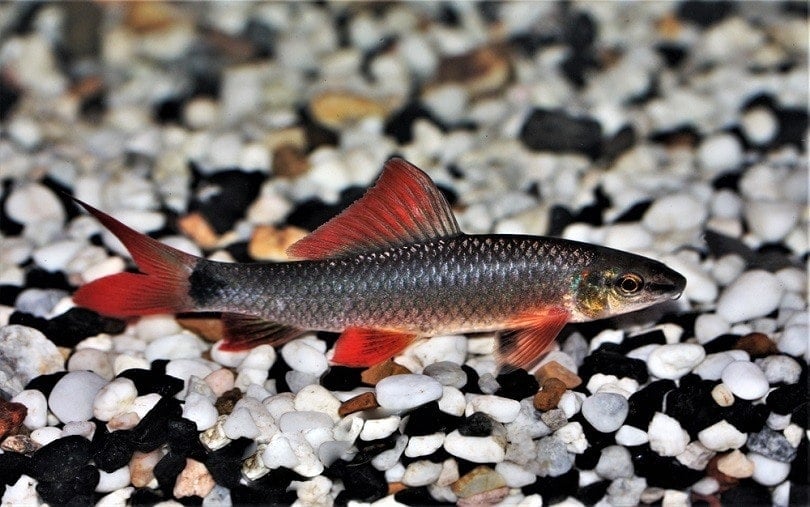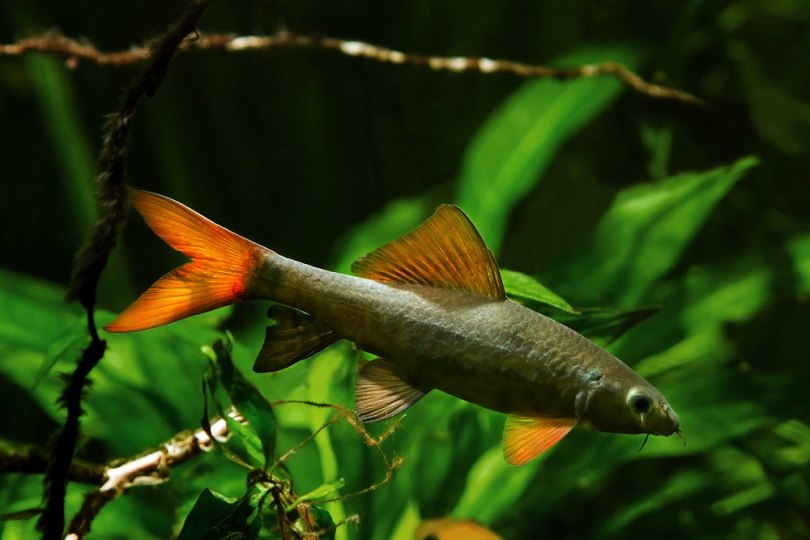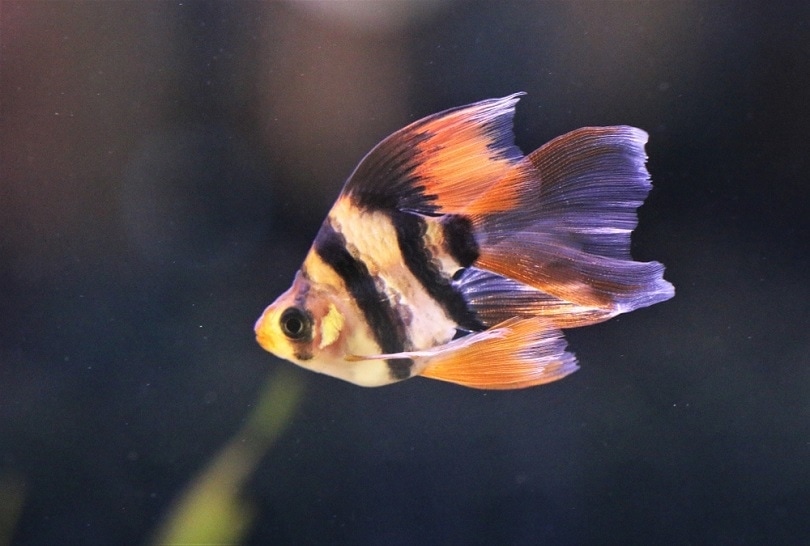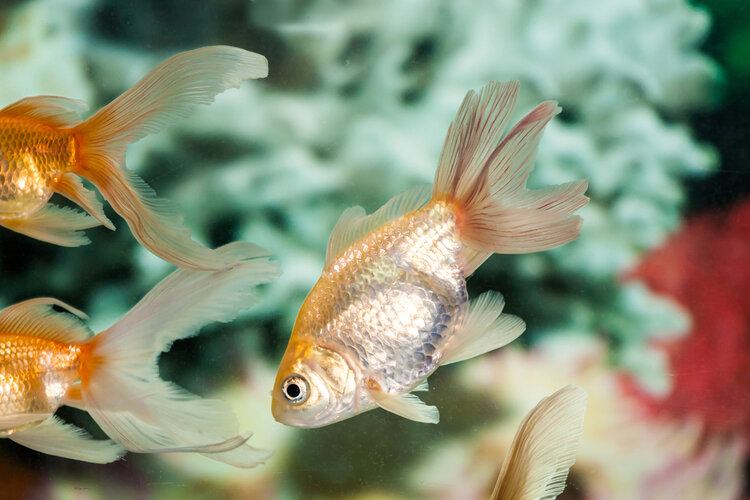Rainbow Shark: Care Guide, Size, Varieties & Lifespan

Updated on

Rainbow sharks make fascinating additions to tropical aquariums. They are commonly sold in pet stores at the minuscule size of 1 inch, attracting aquarists to their unusual beauty.
The rainbow shark is a two-in-one bonus for aquarists. They swim in mid-water and display common characteristics of algae eaters. This is shown by the shark gliding across the substrate, objects, and even the glass panels. They do an excellent job at keeping the substrate and decorations free of leftover food, debris, and algae. Keep reading to learn more about this hardy, territorial species of fish.

Quick Facts about Rainbow Sharks
| Species Name: | Epalzeorhynchos frenatum |
| Family: | Cyprinid |
| Care Level: | Moderately difficult |
| Temperature: | 24°C-28°C |
| Temperament: | Semi-aggressive |
| Color Form: | Albino, red tail, rainbow & Glo-fish colorations |
| Lifespan: | 6-10 years |
| Size: | 6 inches |
| Diet: | Omnivorous |
| Minimum Tank Size: | 40 gallons |
| Tank Set-Up: | Plants, rocks, caves, hiding spots |
| Compatibility: | Moderate |
Rainbow Shark Overview

Rainbow sharks originate from South-East Asia and reside in tropical rivers. Rainbow sharks are commonly known as redfin sharks or ruby sharks. These fish add a boast of color and attitude to tropical community aquariums. Although rainbow sharks are common in fish stores, they are moderately difficult to maintain.
Rainbow sharks are territorial by nature, making claims to a small section of the aquarium as their own. These fish can live individually, with others of their species, and in tropical community aquariums with peaceful top-dwelling fish.
Although these fish do not reach the typical lifespan of many algae eaters, they outlive the common Cory catfish. Rainbow sharks grow particularly fast and bring a sense of vibrancy to aquariums. They are referred to as rainbow sharks because of their red-tailed variety which portrays a red tail fin.
Rainbow sharks can dull the colors of their red fins when stressed. This is commonly seen when they are first introduced into the aquarium, reside in an unsuitable environment, or experience chasing from other fish. Their vibrant red fins will turn to a rusty, transparent color that takes a few days to change back into ruby red fins.
How Much Do Rainbow Sharks Cost?
Rainbow sharks are not on the pricey end. Rainbow sharks can range from $1 to $10. The price depends on the age, health, and finnage the fish displays. A typical pet store that mass breeds rainbow sharks will sell them between the $1 and $3 price range, whereas quality fish stores will charge more as they take in healthy rainbow shark stock, ranging between $4 to $6.
Ordering a rainbow shark online will cost more. This is because you pay for shipping and transport to your doorstep. If you choose fast shipping, you can expect to pay a few dollars extra. In the end, it is worth the extra money when you are rewarded with a healthy fish who has experienced less shipping trauma.

Typical Behavior & Temperament
Rainbow sharks do well on their own and can tolerate each other if the tank is large enough. Although you will occasionally notice chasing amongst the same species, it does not lead to fights or become frequent behavior. Chasing is commonly seen during feeding or the invasion of small territories they claim around the aquarium.
Rainbow sharks are not boisterous fish that take the spotlight in the aquarium, instead preferring to lurk around the bottom of the aquarium, retreating to their safe space which includes rocky and planted spaces. These fish dart to safety when startled, so you should approach the aquarium carefully. Juvenile rainbow sharks are less territorial and can be peaceful amongst other fish.
As they start to mature and reach over 2.5 inches, they claim territories and do not appreciate their territories being invaded by other fish. In community tanks, you may notice them chasing other fish around the aquarium.

Appearance & Varieties
The name of the rainbow shark can be misleading. When we think of a rainbow, we picture a variety of colors. This is untrue for rainbow sharks who only come in more dull variations with up to two main colors marking their bodies. One of the most popular varieties is the red-tailed shark. Unlike the rainbow version, red tails only display a light black or dark grey body with a rust-colored caudal fin. The rainbow shark variety displays rust-colored dorsal, pectoral, caudal, and pelvic fins. The body is either a light black or dark ruby color.
The albino red-tailed shark coloration is hard to find. Albinos vary in colors. Some portray a milky-white body with red fins, while others other a light peach color throughout the entire body. An entirely rare variety of rainbow sharks is sold under the brand name ©GloFish. Glofish sharks appear to glow with unusual colorings that range from greens, pinks, blues, and yellows. The entire shark may display the glowing color or only the body. This is a new practice that has caused genetically modified colors that are not found in the wild. These man-made specimens usually have a shorter lifespan than the average rainbow shark. In some cases, the fish may have a blue hue to their body, this is typically seen with rainbow varieties and not the red-tail variety.
When observing the fish, you will notice an elongated body with a flat abdominal area. The abdomen should not appear sunken as it is usually a sign of starvations or internal parasites. Rainbow sharks have a horizontally long mouth to forage and eat on flat or curved surfaces. They have a short pair of feelers on either side of their mouth to help them navigate tasty morsels of food in the substrate. A healthy rainbow shark will have no visible signs of disease such as fungus, torn fins, or appear to be abnormally thin. New rainbow sharks should be quarantined for 2 weeks before adding them into the main tank.

How to Take Care of Rainbow Sharks
Habitat, Tank Conditions & Setup
Tank/aquarium size
Rainbow sharks do not grow abnormally large. They typically reach a maximum size of 5 to 6 inches depending on food availability and tank size. Although rainbow sharks are sold noticeably young at pet stores, they grow rapidly. You may find yourself having to continuously upgrade to comfortably fit your rainbow shark in an aquarium.
Rainbow sharks of 1 to 2 inches can start in a 30-gallon tank but will quickly grow to require a tank of 55 gallons at minimum. Adult rainbow sharks appreciate a tank size of 75 gallons or more. The larger the tank, the less aggressive they are towards other fish.
Water temperature & pH
Rainbow sharks naturally occur in warm water. This should be replicated in captivity. Rainbow sharks do poorly in cold water and become increasingly susceptible to diseases such as ich, fungal, and bacterial infections.
When you first add your rainbow shark into the aquarium, it is ideal to set the temperature slightly high than normal to help fight off any potential external diseases from the pet store. Slowly lower the temperature after a week once your rainbow shark has settled in its new home.
An ideal temperature range is between 24°C to 28°C, with 27°C being a good temperature for a newly acquired rainbow shark. Never let the temperature drop below 22°C as this encourages illness and lethargy. The temperature should be kept stable using a quality aquarium heater. Rainbow sharks prefer a neutral pH between 6 to 7.5 to remain healthy.
Substrate
Rainbow sharks primarily forage in the substrate, and this makes it important to ensure the substrate you are using is not sharp and will not damage the underside of your shark. Smooth pebbles, sands, or algae mats are recommended.
Plants
Rainbow sharks appreciate live or fake plants to hide in, especially when they are young. They appreciate rocky, planted tanks that create a cave environment. They do not consume plants, so live plants are suitable.
Lighting
Rainbow sharks occur in low-lit rivers, dwelling at the bottom where minimal light reaches. In captivity, you should avoid using artificial lighting. Placing your rainbow shark in a bright environment will cause it to seek shelter. This will result in a shy rainbow shark that is not continually active.
Filtration
Like all aquatic creatures, rainbow sharks require a good filter that filters five times the overall water volume in the aquarium. Regular water changes should be conducted as rainbow sharks are sensitive to spikes in ammonia, nitrite, and nitrates.

Are Rainbow Sharks Good Tank Mates?
When introducing Rainbow sharks into a community tank, you must ensure you have appropriate tankmates. Due to rainbow sharks’ territorial nature, they prefer surface or mid-water dwelling species of fish. Peaceful and fast-moving fish are ideal.
Rainbow sharks should preferably be the only species of aquarium shark in the tank. Pairing rainbow sharks with the correct tank mates are vitally important to keep your rainbow shark stress-free. Below is a list of suitable and unsuitable tankmates for rainbow sharks.
- Danios
- Rasboras
- Neon tetras
- Short-finned betta fish
- Glassfish
- Apple snails
- Plecostomus
- Corydoras
- Livebearers
- Guppies
- Bala sharks
- Iridescent sharks
- Cichlids
- Goldfish
- Oscars
- Angelfish

What to Feed Your Rainbow Shark
Rainbow sharks are omnivores by nature. They readily consume algae and meat-based foods. Rainbow sharks scavenge along the bottom of the aquarium for leftover foods by tankmates, small worms like bloodworms, and rotting plant matter. They can be picky to feed in captivity and generally do not take to foods immediately.
Picky rainbowfish can be fed sinking bottom-dwelling granules. Larger rainbow sharks will happily accept worms and small aquatic insects to be incorporated into their diets. A rainbow shark that is fed a quality diet will be able to maintain a healthy immune system and ward off disease. Rainbow sharks will happily consume short-stranded algae within the aquarium.
- Omnivorous sinking granules or pellets
- Algae wafers
- Shrimp & algae pellets
- Bloodworms
- Tubifex Worms
- Daphnia
- Algae
- Mosquito larvae
Keeping Your Rainbow Shark Healthy
Keeping your rainbow shark healthy is not an easy task. These fish are unsuitable for novice aquarists for good reason. They are easily stressed and susceptible to diseases when cared for improperly. To successfully raise a healthy rainbow shark, you must ensure a few basic requirements are met. Below is a summary of our top three ways to keep your rainbow shark healthy.
- Quality diet: Meeting your rainbow sharks’ dietary needs will ultimately lead to good internal health, which will show from the inside out. A poor diet can result in deformed, starved, or a decrease in lifespan.
- Large tank: Housing any species of fish is never a good idea. When it comes to rainbow sharks, they need as much space as possible. Providing a large tank will lower the stress your rainbow shark will endure by its tankmates.
- Adequate filtration: Ensuring your rainbow shark is kept in clean, filtered water will ensure your rainbow shark can remain healthy externally. Keep the water parameters within the regulated ranges.
Breeding
There is little literature on successfully breeding rainbow sharks. It has only recently been discovered how to successfully breed rainbow sharks in the correct tank conditions. The mating process is like all species of egg layers. The female will deposit eggs and a male will spray milt over the eggs. The eggs will take approximately 5 to 7 days to hatch, and the fry will develop within a 2-to-3-week period.
The females will choose a mate of their choice to engage in the breeding ritual. Rainbow sharks breed best during the colder seasons and the temperature should be adjusted accordingly to encourage breeding.

Are Rainbow Sharks Suitable For Your Aquarium?
If you have a tank over 55 gallons with small peaceful community fish on the suitable tankmates list, the rainbow shark may be the right fish for your aquarium. The tank should have plenty of natural rocky caves and live plants to best replicate the natural environment rainbow sharks thrive in. The tank should be heated to produce tropical temperatures, and no other species of algae eaters or bottom-dwellers should be housed within.
It is recommended to only engage in the keeping of rainbow sharks if you are experienced. Due to the aggressive nature and complications keeping this species to thrive, they are not ideal for beginners. Good knowledge of tropical shark species is needed to successfully raise and mature these fish. We hope this article has provided you with the necessary information you require to raise your rainbow shark.
Check out some of our other tank life species care guides:
- Freshwater Eels: Care Guide, Pictures, Varieties, Lifespan & More
- Siamese Algae Eater: Care Guide, Varieties, Lifespan & More (with Pictures)
- Kuhli Loaches: Care Guide, Varieties, Lifespan & Traits (with Pictures)
Featured Image Credit: Arunee Rodloy, Shutterstock









